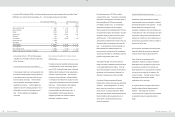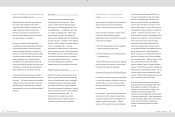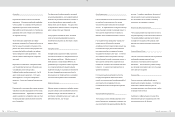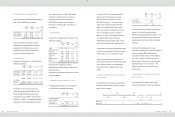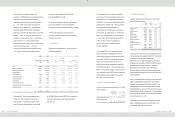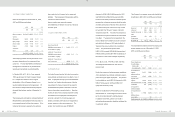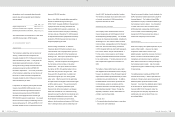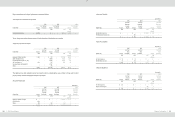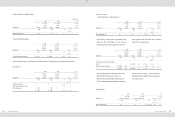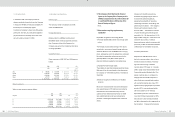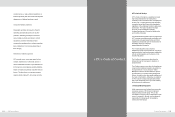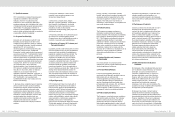HTC 2008 Annual Report Download - page 113
Download and view the complete annual report
Please find page 113 of the 2008 HTC annual report below. You can navigate through the pages in the report by either clicking on the pages listed below, or by using the keyword search tool below to find specific information within the annual report.
Financial Information
| 91
90 |
2008 Annual Report
When the Company did not subscribe for the new
shares issued by BandRich Inc. in May 2006 and
Vitamin D Inc. in September 2008, adjustments of
NT$15,845 thousand and NT$1,689 thousand
(US$52 thousand) were made to the investment’s
carrying value and capital surplus, respectively. As
a result, the capital surplus from long-term equity
investments as of December 31, 2008 was
NT$17,534 thousand (US$535 thousand).
The additional paid-in capital from a merger (Note
1), which took effect on March 1, 2004, was
NT$25,972 thousand. Then, because of treasury
stock retirement in April 2007, the additional
paid-in capital from a merger decreased to
NT$25,756 thousand (US$785 thousand).
Appropriation of Retained Earnings and
Dividend Policy
Based on the Company Law of the ROC and the
Company’s Articles of Incorporation, 10% of the
Company’s annual net income less any deficit
should first be appropriated as legal reserve until
this reserve equals its capital. From the remainder,
there should be appropriations of not more than
3‰ as remuneration to directors and supervisors
and at least 5% as bonuses to employees.
The appropriation of retained earnings should be
proposed by the board of directors and approved
by the stockholders in their annual meeting.
As part of a high-technology industry and a
growing enterprise, the Company considers its
operating environment, industry developments,
and long-term interests of stockholders as well as
its programs to maintain operating efficiency and
meet its capital expenditure budget and financial
goals in determining the stock or cash dividends to
be paid. The Company’s dividend policy stipulates
that at least 50% of total dividends may be
distributed as cash dividends.
Had the Company recognized the employees’
bonuses of NT$531,000 thousand as expenses in
2005, the pro forma earnings per share in 2005
would have decreased from NT$33.26 to
NT$31.76, which were not adjusted retroactively
for the effect of stock dividend distribution in later
years.
Had the Company recognized the employees’
bonuses of NT$2,105,000 thousand as expenses
in 2006, the pro forma earnings per share in 2006
would have decreased from NT$57.85 to
NT$53.03, which were not adjusted retroactively
for the effect of stock dividend distribution in the
following year.
Had the Company recognized the employees’
bonuses of NT$1,313,200 thousand as expenses
in 2007, the pro forma earnings per share in 2007
would have decreased from NT$50.48 to
NT$48.19, which were not adjusted retroactively
for the effect of stock dividend distribution in the
following year.
Based on a resolution passed by the Company’s
board of directors in February 2008, the employee
bonus payable should be appropriated at 18% of
net income less employee bonus expenses. If
the actual amounts subsequently resolved by the
stockholders differ from the proposed amounts, the
differences are recorded in the year of
stockholders’ resolution as a change in accounting
estimate. If bonus shares are resolved to be
distributed to employees, the number of shares is
determined by dividing the amount of bonus by the
closing price (after considering the effect of cash
and stock dividends) of the shares of the day
preceding the stockholders’ meeting.
As of January 17, 2009, the date of the
accompanying independent auditors’ report, the
appropriation of the 2008 earnings had not been
proposed by the Board of Directors. Information
on earnings appropriation can be accessed online
through the Market Observation Post System on
the Web site.
22.TREASURY STOCK
On October 7, 2008, the Company’s board of
directors passed a resolution to buy back 10,000
thousand Company shares from the open market.
The repurchase period was between October 8,
2008 and December 7, 2008, and the repurchase
price ranged from NT$400(US$12) to NT$500
(US$15) per share. If the Company’s share price
was lower than this price range, the Company
might continue to buy back its shares.
The Company bought back 10,000 thousand
shares for NT$3,410,277 thousand (US$103,972
thousand) during the repurchase period.
(In thousands of shares)
Purpose
As of
January 1,
2008
Increase
Decrease
As of
December 31,
2008
For maintaining the
Company’s credit
and stockholders’
equity
-
10,000
-
10,000
On December 12, 2006, the Company’s board of
directors passed a resolution to buy back 5,000
thousand Company shares from the open market.
The repurchase period was between December
13, 2006 and January 19, 2007, and the
repurchase price ranged from NT$601 to NT$800
per share. If the Company’s share price was
lower than this price range, the Company might
continue to buy back its shares.
During the repurchase period, the Company
bought back 3,624 thousand shares, which were
approved to be retired by the Company’s board of
directors in April 2007, for NT$1,991,755
thousand.
Based on the Securities and Exchange Act of the
ROC, the number of reacquired shares should not
exceed 10% of the Company’s issued and
outstanding stocks, and the total purchase amount
should not exceed the sum of the retained
earnings, additional paid-in capital in excess of par,
and realized capital reserve. In addition, the
Company should not pledge its treasury shares nor
exercise voting rights on the shares before their
reissuance.


